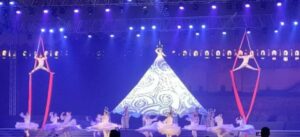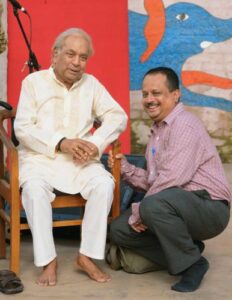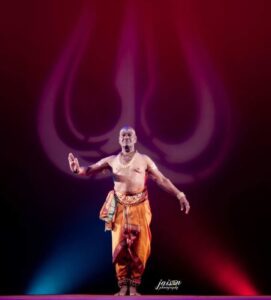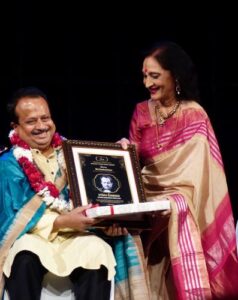Sandeep Dutta, a maverick in Light Design
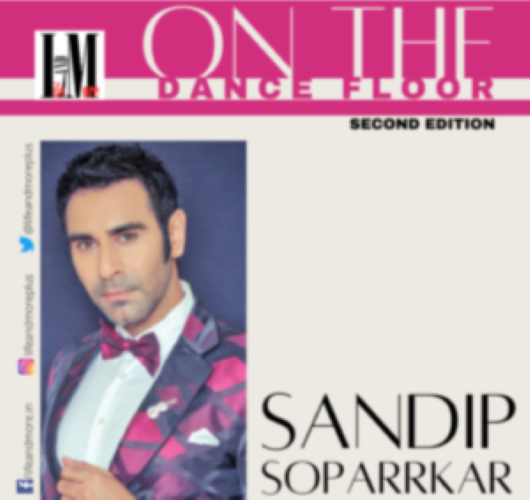
Have you ever thought why some dance shows penetrate into our souls and some dance photos leave an ever lasting impression? Is it just the dance and the dancer or there is more to it? Well, yes, the dance and the dancer indeed are an integral part but what equally matters is the light design. A mix of the two is what touches our lives in a manner we cannot even image. Sandeep Dutta, a maverick in light design, who has made dance shows come alive with his brilliance and talent. I spoke with the supremely talented light magician, excerpts from the interview:
A Career in Light Design, how did it all start for you?
We came to Delhi in 1986 from UP. My father was a doctor and when he retired, we shifted to Delhi. After schooling, I did Electronics from IETE. I was looking for something constructive at that time. Fortunately, I met Gautam Bhattacharya, who became my guru and mentor, he suggested taking up light designing as a career. But at that time, my parents had not heard of light designing. It was in 1991 that I started going out with Gautam Bhattacharya to watch classical programs, since I did not have any classical base. I did not have any family background in the arts but being a Bengali, I had that gene, an interest in culture that is transmitted. I started enjoying dance and music. Gautam-da told me that I could take this up as a career; he would guide me but not to bank on him, and to learn and create my own base. My mother encouraged me, I enjoyed it and started learning. The first step was to learn the basics – choreography, concept, lights, what the dancers think of the lights and vice versa. Learning with him taught me to think about the dancers’ vision. After seven years of learning from him in a guru-shishya parampara, I got my first job as a light designer for a solo show in 1998 and that was the beginning of my work. Later, through Gautam-da, I met R.K. Dhingra, he also guided me a lot. Back then light designing as a career as not easy at all, people never took it seriously. When I started my journey, I worked as an apprentice for Modern Stage Service for free for three to four years, just to learn – where and how the lights are to be put, what angle, what colour etc. To do any light design, you have to have a sense of music – when will it fade out and fade in. Once you have been to a rehearsal, things become clear. Soon things changed and today I am glad to say that I have worked in all the fields – dance, music and theatre.
How important lighting is for a dance?
Dance on stage is incomplete without the right lights. Dancers live in light as fish live in water. The stage space in which they move is their aquarium, their portion of the sea. Within translucent walls and above the stage floor, the lighting supports their flashing buoyance or their arrested sculptural bodies. The dance is fluid and never static.
The art of lighting consists of putting light where you want it and taking it away from where you don’t want it. The designer has to carefully pick and choose what to reveal, how to reveal it and at what point of time to reveal it; therein lies the crux of a successful design. As a light designer, it should be our endeavour to complement & enhance the drama that is unfolding on the stage. We should try to keep it simple and yet be dramatic.
What are the different ways you work on lights?
Light that floods the stage means to the viewer something different than an isolated circle of light on the stage floor. Similarly, light becoming visible slowly makes a different statement than light that flashes on. Bright white light has a different impact than dim blue light. Dance lighting is unique among performance disciplines in large part because dance is concerned first and foremost with movement. While in all performance mediums our focus is on bodies in space, it is in dance where we focus on where and how that body moves. Because our interest in dance is based first on movement, the lighting must be grounded in an approach that seeks out interesting ways to reveal that moving body. In dance, to show off the architectonics of the body and movement, we rely primarily on sidelight positions.
Shows now a days use the back lighting concept, please tell more about it?
Backlight is a term used in visual arts such as photography, film and stage lighting that simply means – “light that comes from behind”. Backlighting doesn’t reflect back to the viewer, it creates a false “halo effect” around surfaces, particularly on curved ones such as the human body. This has the effect of showing the depth and 3 dimensional quality of the performer and making the “stage picture” less 2D. Backlighting also gives the eye some references on stage depth and distances and these visual clues help the audience see the performers as real.
Who all have you enjoyed lighting up?
I have worked in all the major cities of India, Delhi, Mumbai, Pune, Bangalore, Chennai, Hyderabad and many more also in many parts of the world. I’m fortunate enough to work with almost all thespian of our times like Padama Vibhushan Late Pandit Birju Maharaj, Padma Vibhushan Sonal Mansingh, Padma Bhushan Radha Raja Reddy, Padmashree Ranjana Gauhar, Padmashree Geeta Chandran, Dr. Sandhya Purecha, Uma Dogra, Maitreyee Pahari, Shama Bhate and many more. Also had a memorable time working with many youngsters like Alaknanda Dasgupta, Yamini Reddy, Bhavna Reddy, Madhur Gupta and Many more. All of them are loved and revered as Maestro by fellow Indians and me. Each one has his or her own style and work culture. They follow different art forms; it is impossible choose one over the other.
Sandip Soparrkar holds a doctorate in world mythology folklore from Pacific University USA, an honorary doctorate in performing arts from the National American University, He is a World Book Record holder, a well-known Ballroom dancer and a Bollywood choreographer who has been honored with three National Excellence awards, one National Achievement Award and Dada Saheb Phalke award by the Government of India. He can be contacted on sandipsoparrkar06@gmail.com


